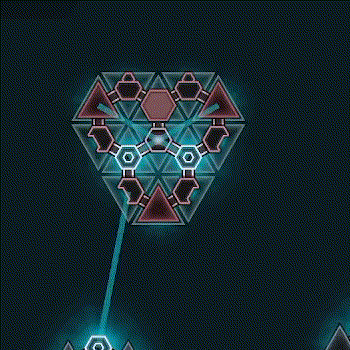Triverse 0.3 moves further into RTS territory with a harvestable crystal resource and incremental unit construction.
Resources
Limited resources force players to make choices. Parts already serve as a kind of resource, but previously you could only obtain them by salvaging neutralized units or from a (temporary) periodic drop. In this release, crystal can be harvested and automatically be converted into parts when placed.

Crystal shows up next to the support counter on the right side of the toolbar. Per-part crystal costs show up in tooltips.

When placing parts, part quantities will be reduced as normal, but if they drop below zero a crystal icon will appear to show the cost to pay for the negative balance.The total crystal quantity on the right will be reduced as well, and if it goes below zero you won’t be able to proceed until removing excess placements.

Similar to the core-capturing mechanic in the previous release, exterior cores can harvest crystal when ordered to do so. Non-depletable crystal deposits now appear on the survival map for harvesting, and the periodic part drops have been removed.
Construction
Following the resource changes, I’ve added a new construction feature. Previously, you could instantly place units without cost except for parts, but now units must be constructed in a process that takes time and leaves them vulnerable. Newly-placed parts start in a constructing state, indicated visually by placement triangles. They start with minimum HP and increase gradually while construction occurs. Parts cannot perform their usual function while under construction, so turrets won’t fire and units will be immobile. Cores within the same unit automatically construct nearby parts, and external cores can assist as well to expedite the process. Overall, construction introduces a time cost, risk factor, and another new use for worker units.

Survival
Survival mode now has a larger play area and five resource deposits. Hostile units will spawn toward the top of the map. If you can survive the first few minutes, you can probably build enough to camp the spawn and survive indefinitely. It’s also a bit too easy to extract parts from the map. These are definitely areas I want to improve in future releases.
Design
The goal of this release was to fill several gameplay gaps that were previously filled by instant building, territory limits, and random part drops. Those shortcuts were useful and allowed proceeding with other parts of the gameplay, but building units didn’t have much cost and territory felt too limited and arbitrary. Random part drops could possibly be avoided by relying on salvaging mechanics, but I want to give players a reason to build and defend a semi-static base.
For the UI, I considered putting non-button status like resources in the upper right of the screen, but I’d really like to keep the UI clean and instead put as much in the toolbar as possible. Putting crystal on the toolbar also means it’s closer to part quantities.
Regarding automatic conversion of crystal to parts, I’ve considered a variety of other options and concluded that the current way would be a good balance of simplicity of implementation and ease of use for players. Alternatives are requiring the player to manually convert, set production ratios for the parts, or build part factories (made of parts?). There are already plenty of factory and RTS games that explore supply chains, and I think it’s better if Triverse focuses on unit building and tactical gameplay.
Strategically, crystal gives you the choice to hoard and defer building decisions until after knowing your opponent’s strategy, or you can spend it immediately to get ahead of your opponent and preemptively strike.
For construction, I originally planned to implement a generic repair and place cells with low HP, but the problem is those newly placed units are immediately functional and may start to wander off. So instead, a new ‘constructing’ state bit is introduced that allows an initial period where units can be repaired until construction is complete (5 turns).